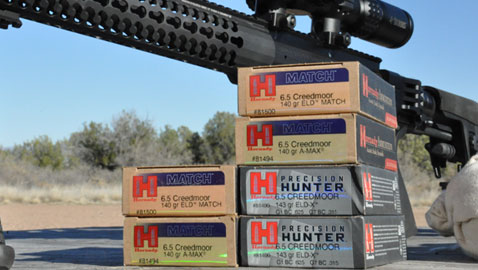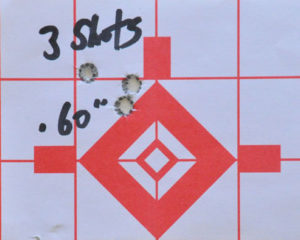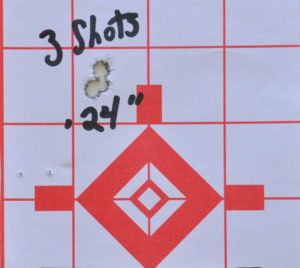 Darn it, Hornady stopped making my favorite load in 6.5 Creedmoor, the 140 grain (gr.) A-Max Match load. This is the ammunition we used about a year ago when Ruger introduced a few of us to the new Ruger Precision Rifle at FTW Ranch in Texas. We shot the rifles with this ammunition and got our dope worked out to “way out there”, in my case to 1400 yards. Fortunately, I was able to lay in a small supply of this ammo before discovering it was being dropped from the catalog. But wait, all is not lost. The reason my favorite load isn’t available anymore is because it has been replaced by an even better one that, as far as I can tell, is even more accurate but is so close in trajectory to the old load that I can substitute it without having to make major changes to my dope. What’s not to like?
Darn it, Hornady stopped making my favorite load in 6.5 Creedmoor, the 140 grain (gr.) A-Max Match load. This is the ammunition we used about a year ago when Ruger introduced a few of us to the new Ruger Precision Rifle at FTW Ranch in Texas. We shot the rifles with this ammunition and got our dope worked out to “way out there”, in my case to 1400 yards. Fortunately, I was able to lay in a small supply of this ammo before discovering it was being dropped from the catalog. But wait, all is not lost. The reason my favorite load isn’t available anymore is because it has been replaced by an even better one that, as far as I can tell, is even more accurate but is so close in trajectory to the old load that I can substitute it without having to make major changes to my dope. What’s not to like?

There is a very good explanation of this new ammunition on Hornady’s website and I encourage you to go there for technical details and ballistic data, so let me give you the executive summary. A couple of years ago the engineers at Hornady started a research project to learn more about external ballistics – what the bullet does in flight – than has previously been known or understood. Part of this research involved using a sophisticated Doppler radar to track rifle bullets throughout their flight. In the past, bullets were tested using chronographs to record velocities at the muzzle, at 100, and perhaps, 200 yards with data then extrapolated from those readings. This worked pretty well but didn’t give a completely accurate picture of the flight of the bullet, especially at long ranges. The engineers had become suspicious because they were getting unpredictable changes in the ballistic coefficient (BC) of some bullets and began to suspect the bullet tip was deforming in flight. Sure enough, the Doppler radar confirmed these findings and showed that the plastic tip of the bullet was melting. This didn’t have much of an effect on accuracy or the BC at close to intermediate ranges but was decreasing BC at longer ranges. Why is this a problem? Well, the higher a ballistic coefficient, the better a bullet carries in flight; that is, the less it drops.

Hornady’s folks set out to design a new, more efficient bullet with a non-melting plastic tip and discovered it not only had a higher BC but the BC actually increased at longer ranges. They called these new bullets Extremely Low Drag (ELD) and created two versions, a Match bullet and the ELD-X, a precision hunting bullet. Both bullets proved to be very accurate in my testing but we’ll get to that in a minute. First, let’s talk about how hunting bullets are usually designed to work. To get a bullet to expand it has to be designed with a hollow point or a soft point, or more recently, a plastic tip designed to be driven back into the bullet on impact to start expansion. Most of these bullets are constructed in such a way that they will expand reliably within a certain velocity range, meaning they might not expand at long range after the velocity has dropped off or may expand too quickly and fail to penetrate if striking at short range when the bullet is moving faster. What Hornady managed to do with the ELD-X bullet is remarkable because this bullet will expand and penetrate at short range and will reliably expand and penetrate at long range, even ranges way beyond those where game animals are usually taken. It is the first, to my knowledge, “all range” hunting bullet.
I received two examples of this new ammunition for testing, the 143gr. ELD-X Precision Hunter and the 140gr. ELD Match, both in 6.5 Creedmoor. Shooting off a bipod at 100 yards on Gunsite’s York Range I ran both loads through the Ruger Precision Rifle (RPR) topped off with a Burris XTR II scope in 4X-20X. Not surprisingly the ammunition shot great with accuracy comparable to what I have experienced with the A-Max load I have the rifle zeroed for. When I do my part and manage not to screw up this rifle and ammunition combination will easily shoot sub minute of angle groups. My best three shot group with the hunting load measured .60” and my best effort with the match load produced a group measuring an astonishing .24”, the best group I have fired in the RPR.
The weather here is getting better and the wind will die down soon. When that happens I hope to wring this ammo out on Gunsite’s long ranges in my RPR and another Ruger that’s on the horizon. Stay tuned.
For more information:
www.hornady.com
www.ruger.com
www.gunsite.com
www.burrisoptics.com
About the Author:
 Ed Head is a regular on Shooting Gallery, Gun Stories and Down Range TV. He has worked for almost 30 years in law enforcement, first in the United States Air Force and then with the United States Border Patrol, retiring as a Field Operations Supervisor. During his Border Patrol career, Ed worked in a variety of patrol, investigative and training capacities. Ed has an extensive background as a firearms instructor, having trained thousands, ranging from beginners to police, military and special operations personnel. Having taught at Gunsite for 20 years, Ed first trained there under the world famous shooting school’s founder, Jeff Cooper, then later ran the school as the operations manager for more than five years. Ed lives in Chino Valley, Arizona, where he continues to teach and write.
Ed Head is a regular on Shooting Gallery, Gun Stories and Down Range TV. He has worked for almost 30 years in law enforcement, first in the United States Air Force and then with the United States Border Patrol, retiring as a Field Operations Supervisor. During his Border Patrol career, Ed worked in a variety of patrol, investigative and training capacities. Ed has an extensive background as a firearms instructor, having trained thousands, ranging from beginners to police, military and special operations personnel. Having taught at Gunsite for 20 years, Ed first trained there under the world famous shooting school’s founder, Jeff Cooper, then later ran the school as the operations manager for more than five years. Ed lives in Chino Valley, Arizona, where he continues to teach and write.
